15 years after the Great Fire, a visionary new master plan builds on the Longwood that rose from the ashes
BY KENT BOOTY
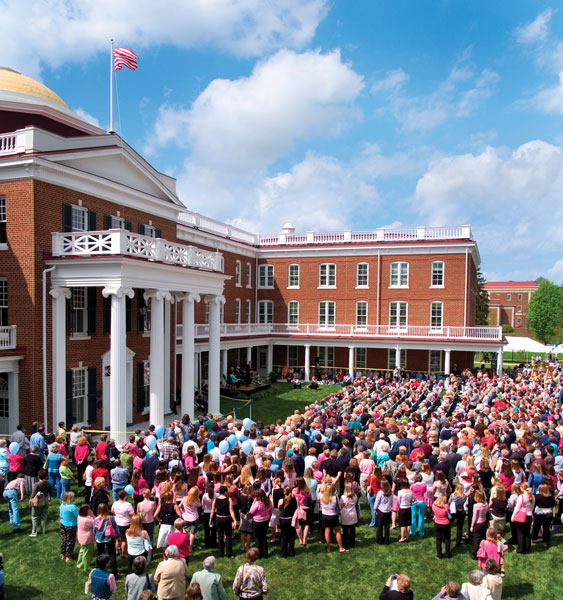
The rededication of Ruffner Hall on April 23, 2005, was a testament to the spirit of the Longwood community.
Next month will mark the 15th anniversary of what has become known to members of the Longwood family as the “Great Fire.” Ruffner Hall, the physical and spiritual heart of the campus, burned to the ground on April 24, 2001. The anniversary of that seminal moment in Longwood history coincides almost exactly with the announcement of a new master plan that builds on a foundation solidified while the rubble still smoldered.
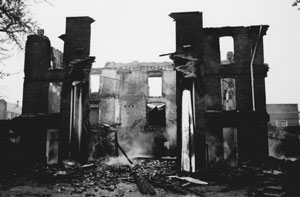
Ruffner after the fire.
“From day one, we knew we had to replicate the university’s history. Changing the architecture was not an option,” said Dave Harnage, then executive vice president for administration and finance. Harnage initially led the recovery effort, but he was just one of many at the time who were committed to bringing Longwood’s signature building back to life—an energy that continues to be felt today.
“The growth response since the fire has generated a renewed enthusiasm and a positive vibe on campus,” said Fred Kuntz, principal of Kuntz & Associates of Alexandria. Kuntz & Associates had been working on a restoration of Ruffner at the time of the fire and was also selected to handle the reconstruction.
 |
The fire, though tragic, led to a revitalized campus center, said Fred Kuntz, principal with the architectural firm that handled the reconstruction. |
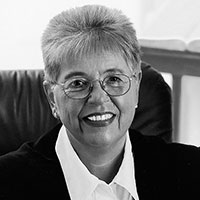 |
Then-President Patricia Cormier: ‘I knew that a rebuilt campus would be a drawing card for recruitment and retention.’ |
“While the fire was a terrible tragedy, it led to a new and revitalized campus center [Ruffner] that pays homage to campus history and recognizes the north end of campus as the historic heart and soul of the university,” Kuntz said. “Longwood has been successful in integrating the pride of its historic past with the progressive development of spaces that will serve students into the future.”
Dr. Patricia Cormier, who was president at the time, said the reconstruction “became a rallying cry and an important catalyst for the rebuilding of campus.”
“This was going on at the same time as preparations for Brock Commons, and Joan Brock [’64] called and asked if I wanted to delay Brock Commons,” said Cormier, who retired in 2010 and lives in Carrboro, N.C., just outside Chapel Hill. I said absolutely not. I knew that a rebuilt campus would be a drawing card for recruitment and retention. The reconstruction thrust the university onto another level.”
Seeing opportunity in the situation came only after a dazed Longwood community processed the experience they had just been through. Faculty, staff and students at that time remember vividly where they were and what they saw.
“I remember standing on High Street with Dr. Cormier and both of us in tears, watching our campus burn. It was a feeling of helplessness,” said Harnage, now Old Dominion University’s chief operating officer.
Dr. Sarah Tanner-Anderson ’02, M.A.’07, also found a sympathetic shoulder that evening. “My adviser, Dr. [Jena] Burges, wrapped her arms around me in a motherly way, and we watched the fire for hours,” said Tanner-Anderson, principal of Amelia County Middle School, who represented the Class of 2002 at the Ruffner rededication in 2005. “I was an English major and a commuter student, so Grainger was my home. Everybody was crying, including professors I saw outside of Grainger.”
| Dr. Sarah Tanner-Anderson ’02 watched the fire for hours with her adviser. |
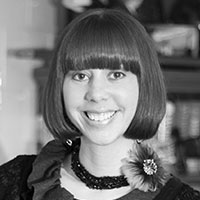 |
 |
‘When the Rotunda dropped … a silence fell over the crowd,’ recalled Nicole Perkins ’05, who was a freshman in 2001. |
| Kendall Lee ’01: ‘… All of a sudden there was this growth and change, which was good.’ |
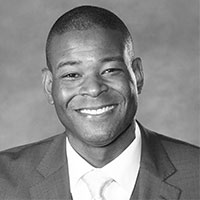 |
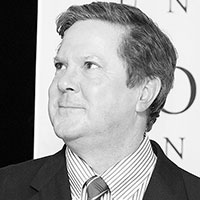 |
John Kirk of Cooper Robertson & Partners, the firm that developed the university’s new master plan, said the path Longwood took in rebuilding is ‘testimony to Longwood’s commitment to its own history and to the quality of the campus.’ |
Stephanie Nelson McWee ’01 and David McWee ’02, then dating and now married, watched the fire together from the lawn of Johns Memorial Church just across High Street. “As a history major, I knew the history of the Rotunda, and a lot of my classes were on third floor Ruffner, so it was like watching my home burn down,” said Stephanie, who lives in Tampa.
“I spent my first three years at Longwood in that building. I cried that night. Just before the Rotunda collapsed, I said ‘Please don’t collapse.’ Right after it collapsed, we heard a hiss and saw a spiral of flame shoot up. It was almost like a tornado.”
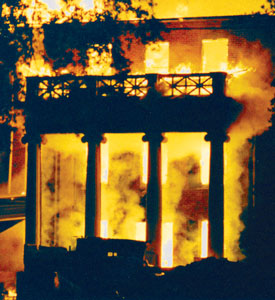
The Rotunda ablaze on April 24, 2001.
Nicole Perkins ’05, then a freshman, also saw the dome collapse, watching from the Confederate statue with two fellow students. One of them, Phil Shaw, who attended Longwood from 2000-02, phoned in the fire at 9:22 p.m. that drizzly Tuesday from an emergency call box after the trio left Curry on their way to get Perkins’ car and go to a video store.
“When the Rotunda dropped, which was the most deafening sound, a silence fell over the crowd,” said Perkins, associate director of campus events in the Office of Alumni and Career Services. “Then the crowd was pushed back. It was intense; it was scary.”
The next morning, Cormier vowed to rebuild Longwood’s signature building to its “former splendor.”
Nearly four years to the day later, her defiant pledge was fulfilled when a new Ruffner, every bit as grand as its predecessor, opened its doors. A new Grainger Hall had opened 18 months earlier, based on the design work of Moseley Architects and project leader George Nasis. The new building replaced the original, which was razed due to smoke and water damage. The reconstruction of the two buildings lost in the Great Fire of 2001 was part of a recovery effort in which Longwood preserved its architectural heritage while revitalizing the campus.
 |
Dave Harnage, executive vice president for administration and finance at the time of the fire, was one of the first to commit to retaining Longwood’s signature style of architecture in the rebuilding process. ‘When you look at those buildings, it’s like the fire never happened,’ he said. |
Though much was unsettled in the fire’s immediate aftermath—“ When I said we were going to rebuild those buildings, I had no idea how we were going to do it,” said Cormier— one detail was decided immediately. The new Ruffner would be built in the red-brick, classical style of architecture that characterized the portion of campus that fronted High Street.
“Ruffner now provides modern classrooms and office spaces in an historic-appearing building,” said Kuntz. “I know of no other campus in Virginia in which faculty, staff, students, alumni and other visitors share space in one building as they do in Ruffner /Blackwell. That’s a really nice feature.”
Longwood’s ability to rebound from the fire also facilitated the redevelopment of several existing buildings along High Street.
“With the reconstruction of Grainger providing offices and classrooms, the addition of a new science building, the renovation of French as the IT center and the repurposed use of Blackwell as an alumni and conference center, Longwood is turning a new face to the world within the context of the historic campus center,” Kuntz said.
Some 20 percent of Longwood’s academic space was lost in the fire, said Dick Bratcher, former vice president for facilities management and real property, who assumed overall responsibility for recovery efforts after Harnage left Longwood in 2002.
“From day one, we knew we had to replicate the university’s history. Changing the architecture was not an option.”
— DAVE HARNAGE, FORMER EXECUTIVE VICE PRESIDENT FOR ADMINISTRATION AND FINANCE
A significant amount of classroom and dorm space has been added or renovated since 2001, said Kuntz, who worked on dozens of Longwood projects from the early 1980s until retiring in May 2015. Much of that classroom space is in Grainger and Ruffner. “You have quite a modern package to present to students within the context of a historic campus,” he added.
On the outside, the new Ruffner and Grainger are indistinguishable from their predecessors. The interior of the Rotunda section in Ruffner, where Kuntz paid especially close attention to “maintaining the historic identity,” also is a dead ringer for the original version.
“The recovery was absolutely phenomenal, a textbook recovery,” said Harnage. “I’m extremely proud of all the folks who contributed. When you look at those buildings, it’s like the fire never happened.”
Surprisingly, the most lasting aspect of the fire was not a feeling of loss but instead an infusion of energy. Kendall Lee ’01, president of the Alumni Association, calls that period an “interesting time in Longwood’s history.”
“You had not only the fire but the name change and Brock Commons,” he said. “For a long time, not much had changed at Longwood, but then, all of a sudden, there was all this growth and change, which was good. Even though it was tragic, the fire provided an opportunity to propel us into the future. It was a new beginning.”
 |
Richard Bratcher, retired vice president for facilities management and real property, assumed responsibility for recovery efforts in 2002. |
At an assembly the day after the fire, Cormier called Longwood a “tough old bird” that would “rise from the ashes.”
And that’s just what happened. The legacy of the fire is a stronger Longwood—as an integral part of the Farmville community, as an institution of higher learning and as a physical campus that impresses visitors with its classic architecture and beauty.
The new master plan, aptly named “Place Matters,” builds on that perfect platform, said John Kirk of Cooper Robertson & Partners, the world-renowned New York-based architecture and planning firm that worked closely with Longwood to develop the plan (see story online).
“That Longwood’s leadership, after the tragic fire 15 years ago, chose to rebuild Ruffner just as it was originally, was not only the correct thing to do historically—it was the correct thing to do with respect to preserving an important piece of urban fabric: High Street,” said Kirk, the lead partner on the project. “A gesture that bold sends a clear message—a message that was not lost on us. That decision is testimony to Longwood’s commitment to its own history and to the quality of the campus, as well as its commitment to contributing positively to the fabric of Farmville.”
